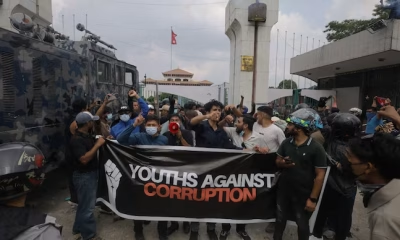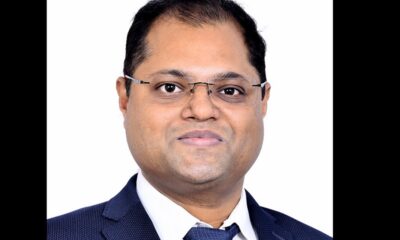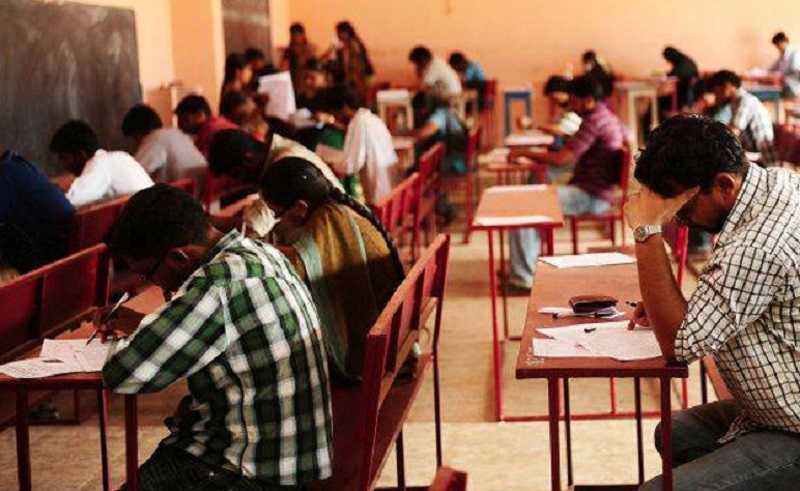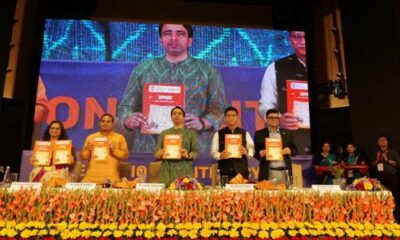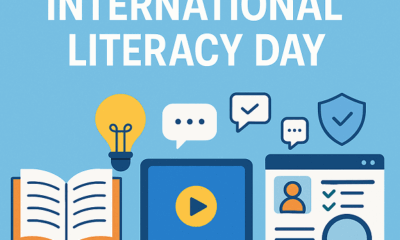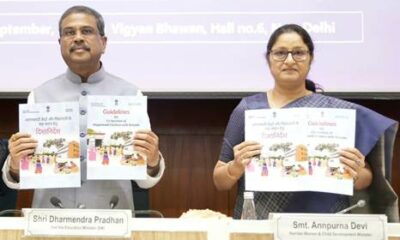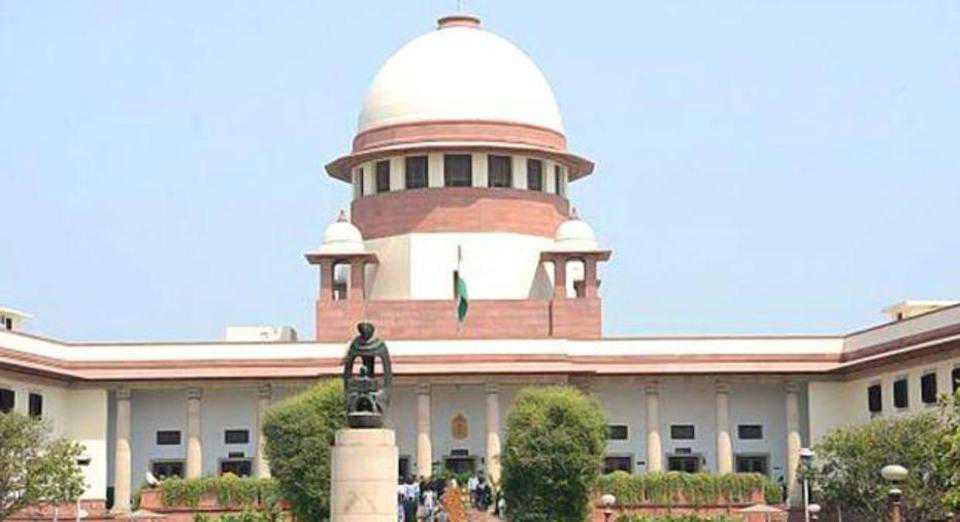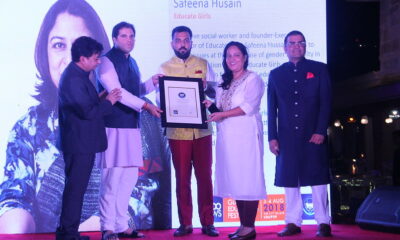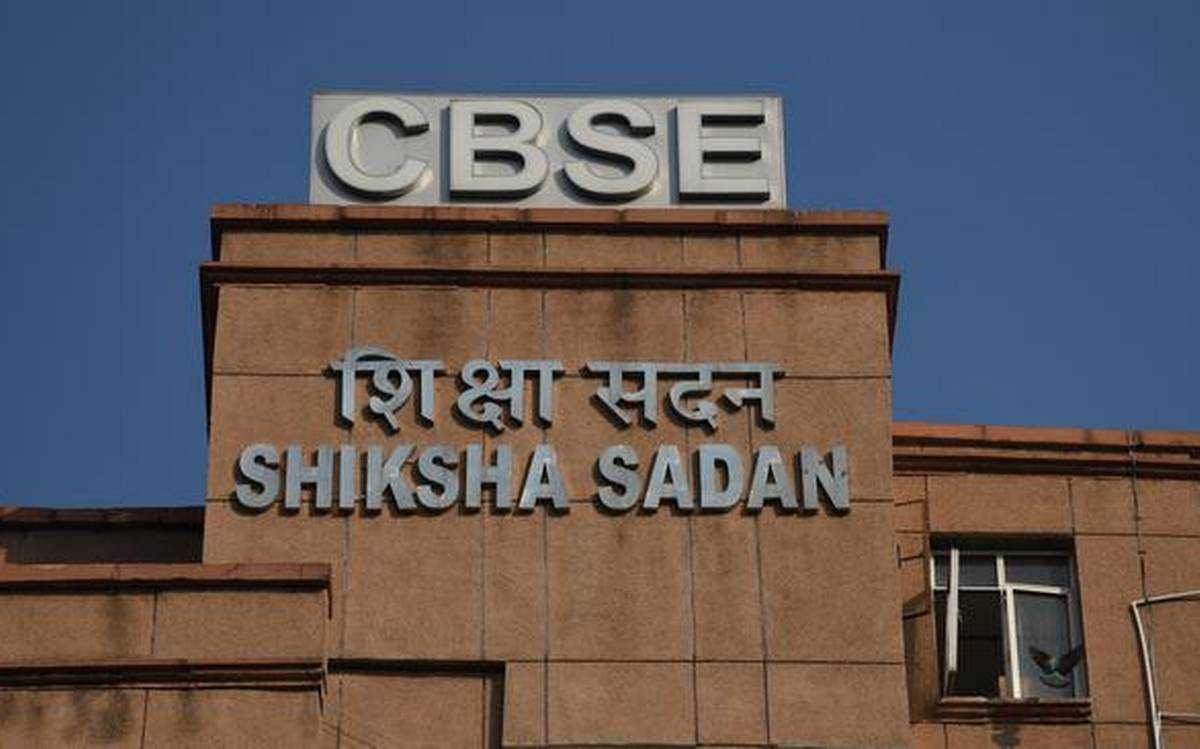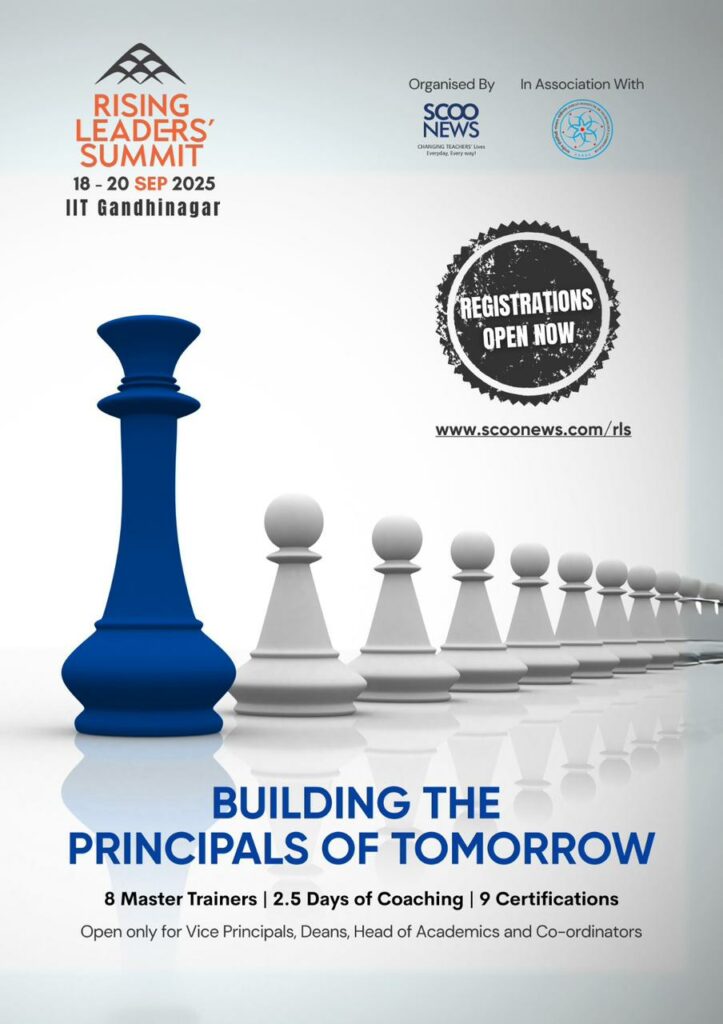Knowledge
Every child must have the right to education irrespective of their background.
Unfortunately in India we have different systems of education. A system for the elite, mediocre, low income groups and the poor. Due to this segregation, quality cannot be ensured.
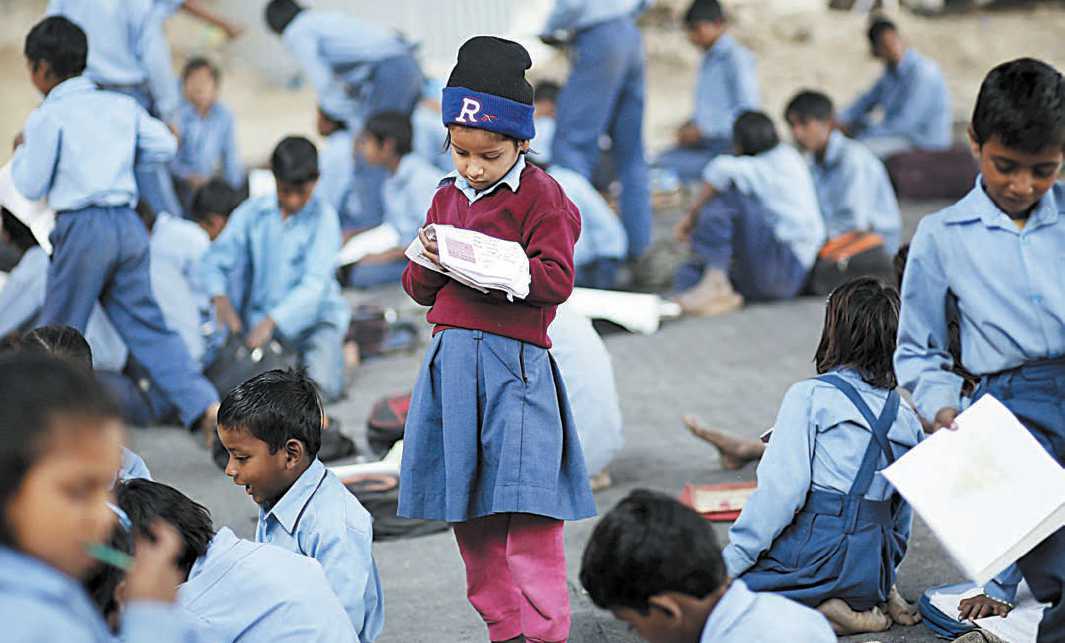
The National Convener of the RTE Forum Ambarish Rai is a man who’s not very popular among the politicians as he raised very controversial questions regarding the state of the education systems and policies in the country. Ambarish hails from a landlord family with his father being the chief medical officer in the state of Uttar Pradesh.
Influenced by Julius Fuchik, a Czech revolutionary and Shahid Bhagat Singh, he started his education movement during his student days against the dual system of education in India. He held a rally from Varanasi to Dehradun. He and fellow protestors protested in front of the Doon school considering that this school had introduced the dual education system in the country. They were lathi charged and arrested.
50 years ago the first education commission led by Daulat Singh Kothari recommended a common school system because schools are a place of socialization. Ambarish says that every child whether rich or poor, upper or lower caste should come under one roof to learn from each other and form a big strong society. Bringing integration in the society has to start from education. Since India still has a segregated hierarchical society he started the education movement.
In a case called the Unnikrishnan judgement he stated as an example, the Supreme Court said that “Education is the right to life”. If people were not educated then they weren’t leading dignified lives. It is the state’s duty to provide quality education to every child upto the age of 14 years, and if resources permitted then that education should go beyond 14 years.
Ambarish Rai formed an organisation in the year 2000 by bringing people together from the society and fought for the fundamental right to education in the constitution to provide education upto the age of 18 years. He brought 40,000 people to the Ram- Leela maidan in Delhi in 2001 to make pre- primary and higher secondary education compulsory.
If there is no equality then there won’t be quality in education. Quality is not isolated but is a perspective. Improvement in the personality of a child comes from the quality of the environment, quality of the teacher, infrastructure and a good curriculum. This will not be possible if the system is not equal.
Unfortunately in India we have different systems of education. A system for the elite, mediocre, low income groups and the poor. Due to this segregation, quality cannot be ensured. A campaign for common school systems was started to focus on passing a law to provide suggestions to correct the system. The group contained intellectuals, people from the masses, professors, the former foreign secretary, educationists and universities to provide suggestions to the drafting committee.
It was Ambarish’s dream to bring all the children together and there be no discrimination in education. The government didn’t quantify the expenditure needed for it. It would require the full extent of resources and commitment of the state. There should be 75 thousand crores additional funds for the implementation of RTE and if every year up to 5 years, an additional amount of 75 thousand crores were brought to the RTE then education could be universalised. But the government has allotted only 25 thousand crores per year (not an additional fund) in the total budget.
Due to the lack of resources only 9.5% of the schools were made RTE compliant. It is a bad situation. The law that was passed came after a 100 years struggle and should not be allowed to go in vain. So in 2010 Ambarish formed the RTE forum which included 10,000 grass root organisations that had educationists, Dalit movements, minority movements, movements working for displacement, movements working for tribal areas come together. Education is an agenda that brought all the people together and they started the annual stock taking convention and brought state reports annually.
RTE is the largest civil society platform on education in India where everybody comes together and raises issues and submits their recommendations.
ScooNews interviewed him and asked him a few questions.
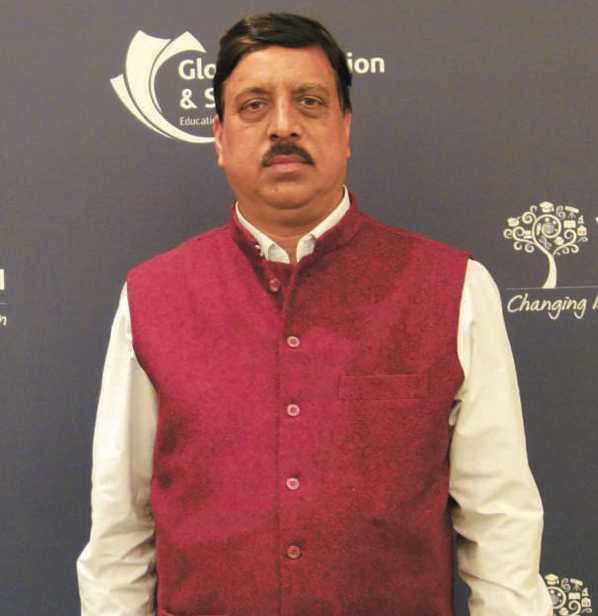
Have you had an open debate with the MHRD on a public platform?
50 years ago Kothari had said 6% had to be allocated from the GDP for education and 3% has to go to secondary education. Nowadays we are investing less than 4%. The issue that we face today is that there are 5 lakh teacher vacancies and 6 lakhs are contractual teachers. When Rs. 2.5 lakhs is paid as monthly salary for a cabinet secretary and only Rs.3000-5000 is paid a month to teachers, then what is the dignity of the teachers? Teachers work and are overburdened. They are made to do election duties, census, accounts, aadhar cards, etc. Teachers are responsible for making the future citizens of India.
They have been given a precious job but are demotivated from doing their original duty. Without training or focus on education or child centric teachers or the right qualifications you can’t bring quality education. These are the problems.
The school scenario in India is horrible. The UN has called for the universalization for secondary education. But in India according to the census still 8 crore children are out of schools. The MHRD brought data in 2013 that 6 million children are out of schools and that is a big number. The biggest challenge are the dropouts. Children are not completing their education. 40% of the children drop out before they complete their 8th std and 60% drop out before they complete their 12th std.
Among the drop outs are the Adivasis, Dalits, Muslims, children from the remote areas and mostly the girl child. For the present no road map for education has been declared by the government of India. Resources have also come down. The UPA government has introduced 2% cess to fill the gaps. 65% of the funds come from cess. The original funding for education was declined. So cess has become the basic source for funding. This just goes to show that the people are being cheated.
Private sectors are coming in, but a regulation must be set for the private sectors. Bridge International Academy and Pearsons run the Omega schools. They charge 6 dollars as their monthly fees. I have visited their schools in Nairobi and they are in a bad state with no proper hygiene, qualified staff or even clean drinking water.
Bridge International has just signed a MOU with the Andhra Pradesh government of India. They have decided to give up 4,000 government schools to Bridge International to run them under low cost schools. The government is just abdicating its responsibilities.
There are only 400 teacher training institutes run by the government. 92% of the other institutes are run by private sectors. Parameters have to be set for the government and private sectors. Kendriya Vidyalaya, Prathibha Vidyalaya are government schools but they get 10 times the allocation and the teachers are not duty bound to do any other work.
You have been demanding RTE for children under the age of 6yrs of age. But research says that children below that age should be left to bloom. How do you handle these contradictions?
Private systems runs nursery schools and government systems run it under the ICDS. It is a big scheme in Asia and deals with malnutrition, health issues and education. The education component in The ICDS is very weak. Children under the age of 6 should have the legal right to education only then the government will invest money across the K-12 sector. The law will ensure the resources for those children and that they have comprehensive legal entitlement for all children upto the age of 18 years.
The biggest challenge are the dropouts. Children are not completing their education. 40% of the children drop out before they complete their 8th std and 60% drop out before they complete their 12th std.
You are from Delhi. How would you rate Manish Sisodia as the education minister?
The Delhi government has done a good job on education. The AAP has increased the education budget by 24% which has been a substantial increase. The focus area that they have chosen is education. There are 27,000 teachers and money should be invested in training them. Bringing teachers from other countries like Finland will not work. But AAP is doing a better job than the rest, but they should be open to suggestions. They brought the Chunauti Program in 3 levels which is wrong. But their intentions are good.
What do you do besides being an RTE activist? How do you earn your daily bread and butter?
I work as a counsel for social development. It is a reputed research industry. I’m using that research and study to build a national movement. I take a fixed salary which takes care of my personal expenses. We get contributions from the people as we are critical of the government.
I’m sure you have watched the Anil Kapoor movie ‘Nayak’. What would you do if you became the minister for HRD for India? What are the two things that you would change?
I would force the finance minister to prioritise education and I would strengthen and re-organise the education system on the basis of equitable and quality education.
Any political desires in the coming days?
No, I don’t think like that as politics is very volatile.
India has a long way to go to clean up and change the systems that are in place. Though small changes are being made it is instrumental to make sure not to deprive the future generations of the right to education.
This article was originally published in the May 2017 issue of ScooNews magazine. Subscribe to ScooNews Magazine today to have more such stories delivered to your desk every month.
Education
UK and US Tighten Student Visas: What Indian Schools and Students Must Know

The tightening of student visa policies in the US and UK has created understandable anxiety among Indian families.
In the UK, the Graduate Route visa may be reduced from two years to 18 months for undergraduates and master’s graduates, while doctoral students may keep three years. Most taught master’s students can no longer bring dependents, the country has raised proof of funds by over 11%, moved to digital e-visas and tightened university compliance.
The US has proposed limiting the F-1 visa to a fixed four-year term, requiring extensions for longer programmes such as PhDs. Interview waivers have been eliminated, and third-country applications are no longer permitted. Backlogs at Indian consulates have worsened, and a new $250 Visa Integrity Fee will soon add to costs.
While complex, these changes reflect a global trend: governments are balancing immigration management with continued student flows. For Indian applicants, this means approaching the process with a sharper focus and stronger preparation.
What these changes mean for Indian students
The proposed cut of the Graduate Route visa to 18 months may cause concern, but this timeframe is enough to build career foundations, especially for students who engage early with employers. Restrictions on dependants may deter older applicants, but younger students will still find the UK attractive. The move to digital e-visas actually simplifies the verification process, while higher proof of funds requirements will require earlier financial planning. Additionally, English language changes should not affect Indian applicants, who already meet or exceed the required standards.
In the US, the proposed four-year F-1 limit introduces uncertainty for PhD students; yet, the country still offers unmatched academic choices, world-class research opportunities, and globally valued degrees. The loss of interview waivers, the ban on third-country applications and the new fee add costs and delays, but with early planning and budgeting, these hurdles are manageable. For many families, the academic ecosystem, extensive networks and long-term career benefits of a US education outweigh the administrative challenges.
How admissions counsellors and schools can guide students
Schools and counsellors now have a greater responsibility. Planning must begin early, whether preparing for tests, selecting courses or booking visa appointments, so backlogs and rule changes cause less disruption. Financial planning is equally critical, as higher UK proof of funds and new US fees make it essential to understand costs well in advance. Counsellors should also help students think long term, making strategic academic and career choices while exploring alternatives beyond the US and UK. With preparation and broad awareness, families can navigate uncertainty without losing sight of their goals.
Looking beyond the US and UK
These changes should not deter Indian families from considering the US or UK. Both remain prestigious destinations with world-class academic ecosystems. At the same time, I encourage families to keep alternatives in mind. Canada, Ireland, Australia and parts of Europe offer attractive post-study work options, while Singapore, Japan and the UAE are emerging as strong contenders closer to home.
In fact, at The Red Pen, pre-COVID, we saw families looking at an average of two destinations. This has now moved to 3.2. Keeping options open is a good idea.
Students can also explore new-age Indian universities such as Ashoka, Krea, Plaksha, FLAME and Jindal, which offer programmes on par with international standards. In addition, 12 global universities are opening campuses in India. While Deakin University, Wollongong University and the University of Southampton are already established, new entrants from 2026 include the Illinois Institute of Technology, University of Liverpool, Queen’s University Belfast, Coventry University, University of York, University of Western Australia, University of Aberdeen, Istituto Europeo di Design and Western Sydney University.
While tighter visa rules demand careful planning, expert guidance ensures that international education remains firmly within reach.
This article is authored by-

Namita Mehta- President and Partner, The Red Pen
Namita drives business growth and global partnerships at The Red Pen, representing the firm at international education forums and building key alliances, including a landmark collaboration with U.S. News & World Report. Recognised among BW Education’s 40 Under 40 and The PIE’s 50 Voices in Leadership, she has twice been shortlisted for the HerRising Awards. Namita has judged the PIE Education Awards, spoken at HSBC, Ashoka University, IC3 and Master’s Union, and contributed to leading publications such as Economic Times, Mint, Hindustan Times and The PIE News. She also serves on the advisory board of The Outreach Collective.
Education
International Literacy Day 2025: Beyond Reading and Writing in the Digital Era
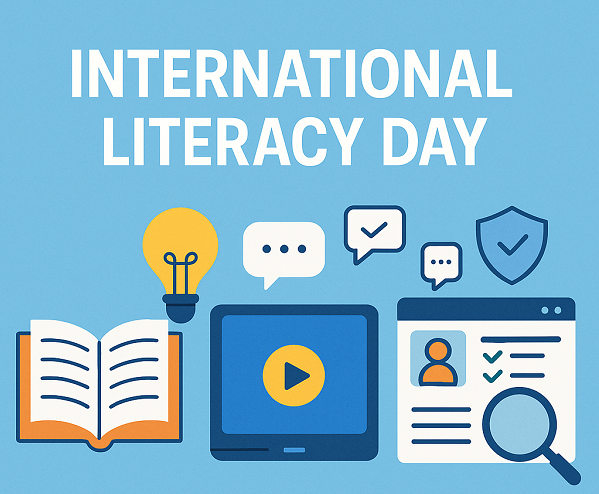
“Education is not only the birthright of every human being but also the weapon of social change.”
Dr B. R. Ambedkar’s words carry even more weight today as we celebrate International Literacy Day 2025. This year’s theme, “Promoting literacy in the digital era,” reminds us that literacy no longer begins and ends with pen and paper.
A Journey Worth Remembering
India’s literacy story is one of resilience. In 1951, only 16 out of every 100 Indians could read and write. By 2022, that number had climbed to 77.7 per cent. The Right to Education Act of 2009 opened the doors of schools to millions who might otherwise have been left behind. Yet numbers alone do not tell the full story. Getting children into classrooms was only the first battle. The bigger challenge lies in what and how they learn.
Literacy in the Age of Screens
In a world where screens dominate, literacy now means much more than decoding text. It is about being able to access, understand, evaluate, and create digital content in safe and responsible ways. A teenager scrolling endlessly on social media might look “digitally literate,” but true literacy asks whether that teenager can spot a fake news story, respond appropriately to cyberbullying, or understand that their digital footprint will outlive their mood.
The dangers are real. A BBC feature this year explained how adolescence itself makes young people more vulnerable to online manipulation because their brains are wired for risk-taking and peer approval. Platforms exploit these vulnerabilities with algorithms that feed them echo chambers of extreme views and endless scrolling loops. What looks like harmless entertainment often becomes a powerful shaper of values and identities.
At the same time, teenagers are seeking comfort in unexpected places. An ETV Bharat report revealed that many Indian students now turn to AI chatbots for emotional support. Experts worry that without proper guidance, children may start to trust technology more than people, with little understanding of how these systems work or what agendas they may carry. Digital literacy, therefore, is not simply about knowing how to use a device but about learning how to navigate relationships, trust, and choices in a digital-first world.
The Missing Lessons
Alongside digital literacy, we are also missing some of the most practical lessons of life. An India Today feature pointed out that while our students can solve complex equations, very few know how to calculate tax, understand savings, or even read the fine print of a bank loan. In an age of instant loans and digital payment apps, this lack of financial literacy is dangerous. Children should be learning how to protect themselves from online scams, how to recognise manipulative advertisements, and how to make decisions that safeguard their futures.
The truth is, literacy today is incomplete without responsibility. Children may be skilled at clicking, posting, or streaming, but if they do not know what to believe, what to share, and what to ignore, they are vulnerable. Civic sense must become part of the digital literacy package. How we behave online is not separate from who we are as citizens. Words can wound, misinformation can destabilise, and silence in the face of bullying can be as harmful as participation.
For India to truly lead in the digital era, we must expand our vision of education. That means increasing education budgets, investing in teacher training, and ensuring that technology-enabled learning does not just deliver content but builds character. It also means recognising that the skills of tomorrow include empathy, resilience, financial wisdom, and civic responsibility.
Ambedkar reminded us that education is the most powerful weapon of social change. In 2025, that weapon is not only the ability to read books but the ability to read the world. Literacy is about survival, about belonging, and about preparing our children not just to live in the digital era but to shape it responsibly.
International Literacy Day should remind us that while we have come far since 1951, the journey is far from over. The future depends on whether we can teach the next generation not only to read and write, but also to choose wisely, live responsibly, and stand tall as citizens of a digital world.
Education
Beyond the Numbers: Reading Between the Lines of UDISE+ 2024–25
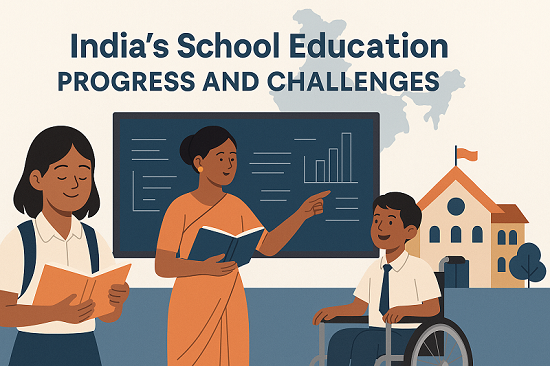
The Ministry of Education’s latest Unified District Information System for Education Plus (UDISE+) 2024–25 report offers an important snapshot of India’s school education. The numbers reveal progress across teachers, enrolments, infrastructure, and gender representation. But as with any large-scale dataset, the fuller story emerges when these achievements are held against persistent challenges on the ground.
Key Improvements Highlighted in the Report
Teachers and Student Ratios
For the first time, India has crossed the one crore mark in the number of teachers. From 94.8 lakh in 2022–23 to over 1.01 crore in 2024–25, the increase represents a 6.7% rise within two years. The Pupil-Teacher Ratio (PTR) too has improved sharply, now standing at 10 for the foundational stage, 13 at the preparatory level, 17 in middle school, and 21 in secondary. All of these are comfortably better than NEP 2020’s recommendation of 30:1, suggesting children now have more access to individual attention.
Dropouts and Retention
Dropout rates have fallen across the board. At the preparatory stage, they are down to 2.3%; in middle school to 3.5%; and in secondary to 8.2%. Retention, meanwhile, has climbed, with 92.4% of students staying on through the preparatory stage, 82.8% at middle, and 47.2% at secondary—supported by the increase in schools offering higher grades.
Transition and Enrolment
More children are continuing their education without breaks. Transition from foundational to preparatory is up to 98.6%, and from middle to secondary to 86.6%. Gross Enrolment Ratio (GER) has also risen, with secondary education seeing an uptick from 66.5% to 68.5%.
Infrastructure Growth
Infrastructure remains a bright spot. Over 93% of schools now have electricity, 99% provide safe drinking water, and 97% are equipped with girls’ toilets. Computer access has grown to 64.7%, internet access to 63.5%, and more than half of schools now have ramps and handrails, improving accessibility.
Gender Representation
Representation of women in teaching has crossed 54%, and girls’ enrolment has edged up to 48.3%, showing slow but steady progress towards gender parity.
Where the Numbers Need Context
While the report reflects genuine gains, the full picture requires a closer look at what these numbers mean in practice.
Teachers: Quantity vs Quality
Crossing the one-crore milestone is historic. Yet reports continue to highlight shortages in subject specialists and concerns about teacher training. A strong student-teacher ratio is valuable only if classrooms are led by well-prepared, motivated educators.
Dropouts: Regional Gaps Persist
The steady fall in dropout rates is promising, but averages mask uneven realities. States like Bihar still struggle with alarming dropout figures, particularly among girls and marginalised communities. National averages hide state-level realities.
Access Without Schools
It is encouraging to see single-teacher and zero-enrolment schools on the decline. However, the deeper problem isn’t just these schools but the absence of schools altogether in thousands of villages. Maharashtra alone has over 8,000 villages without schools. That’s not a statistic you’ll find in the UDISE+ summary, but it matters when we talk about access.
Digital Infrastructure: From Presence to Practice
Computer and internet access are on the rise, yet, other surveys suggest that many of these facilities remain underused, serving as placeholders for inspections rather than as tools for learning. Less than a quarter of India’s 1.47 million schools have smart classrooms. Digital literacy among students and teachers is patchy at best. So while infrastructure is expanding, its integration into actual pedagogy lags far behind.
Inclusion: Beyond Ramps
Ramps and handrails are a welcome start, but inclusion for children with disabilities requires much more. How many schools have accessible toilets, special educators, or learning aids for children with disabilities? And the bigger question: how many children with disabilities are actually enrolled and attending school regularly? Current data rarely tells us this.
Gender: Representation Without Leadership
Girls’ enrolment is up slightly to 48.3%. Female teachers now account for 54.2% of the workforce. Encouraging signs, yes. But leadership remains a male stronghold. Across higher education, only about 9.5% of institutions in India are led by women. At the school level too, women remain underrepresented in principal and leadership roles. Representation in classrooms is improving; representation in decision-making is not.
Reading the Report Holistically
The UDISE+ 2024–25 findings point to a system that is steadily improving access, retention, and infrastructure. But progress cannot be measured in isolation. Numbers must be matched with quality, access must be inclusive, and representation must extend to leadership. A fuller picture of Indian education comes not from rose-tinted fragments but from an honest balance of achievements and unfinished work.
Edutainment
Weaving Social-Emotional Learning into the Curriculum
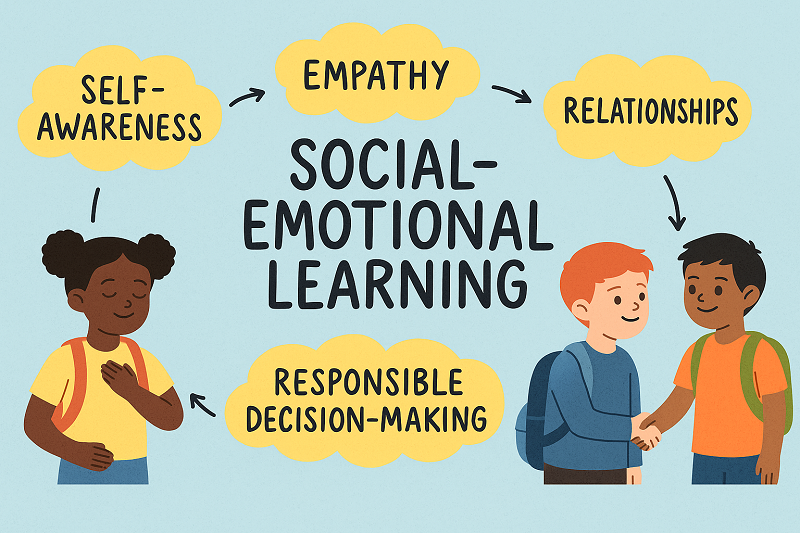
When we think of school learning, the first things that come to mind are math equations, science experiments, history timelines, and grammar rules. But education isn’t only about academic skills—it’s also about preparing students for life. This is where Social-Emotional Learning (SEL) steps in, transforming classrooms into spaces that nurture not just minds, but hearts.
What is Social-Emotional Learning?
Social-Emotional Learning is the process through which students acquire and apply skills to:
- Understand and manage emotions
- Build healthy relationships
- Show empathy for others
- Make responsible decisions
- Set and achieve positive goals
In simpler terms, SEL is about helping students become self-aware, emotionally intelligent, and socially responsible.
Why Should SEL Be Part of the Curriculum?
For decades, education focused on the “3 Rs” – reading, writing, and arithmetic. Today, we know that EQ (Emotional Quotient) can be just as important as IQ. Studies show that integrating SEL into the curriculum leads to:
- Improved academic performance
- Reduced stress and anxiety
- Fewer behavioural issues
- Stronger peer relationships
- Better conflict-resolution skills
A student who learns how to manage frustration or work well in a team is more likely to thrive both inside and outside the classroom.
How SEL Fits into Different Subjects
- Language and Literature – Discussing characters’ feelings in a story builds empathy and perspective-taking.
- Science – Group experiments encourage collaboration and respectful communication.
- Mathematics – Problem-solving in pairs or teams fosters patience and perseverance.
- Social Studies – Exploring diverse cultures promotes acceptance and respect.
Practical Ways to Embed SEL into Curriculum
- Morning check-ins: A quick emotional “temperature check” helps teachers understand students’ moods.
- Role-play activities: Encourage students to act out scenarios that require empathy or problem-solving.
- Collaborative projects: Promote teamwork, negotiation, and leadership skills.
- Mindfulness breaks: Simple breathing exercises can improve focus and emotional balance.
When SEL is woven into lesson plans, we move from an education system that simply imparts knowledge to one that shapes compassionate, resilient, and adaptable individuals. In a world that is constantly changing, these life skills are not optional—they are essential.
Final Sum-Up
Social-Emotional Learning doesn’t replace academic learning; it enriches it. By combining books with empathy, logic with kindness, and grades with grit, we can prepare students not just for exams, but for life.
This article is authored by-
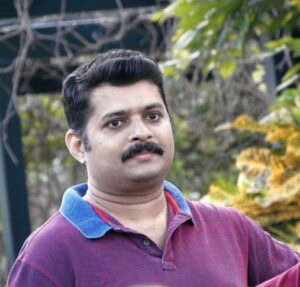
Ranjith P C, Head- Curriculum Excellence, TVS Education
Education
Education with Purpose: Shaping Responsible Learners for a Better Tomorrow

Education is the wellspring of civilization. It begets arts, culture, sciences, and polity to create a society oriented towards discovery and development. Through the ages, education has evolved to meet the needs of the times, and presently, it has reached an inflection point. The inexorable advancement of technology, abundance of information, pressing societal challenges and climate crisis have compelled educators to re-imagine education for the 21st century.
With the rapid prevalence of generative artificial intelligence, the question rightly being asked is: “What should we teach children when almost all answers can be readily had from AI?” The education of tomorrow would reward critical thinking over knowledge. That is what our focus and onus as educators should be. Children, being the digital natives, are more inclined to leverage the full potential of technology. It is up to us to help them realize and understand that AI should augment – not replace – HI (human intelligence). To think critically, to understand, to create and innovate should always be the preserve of humans. The ‘human-first, tech forward’ approach should become the cornerstone of education, going ahead.
An equal focus has to be on building skills, values and attitudes to address the most pressing problems of the world today. The World Economic Forum’s Education 4.0 framework underscores the importance of nurturing global citizenship, environmental stewardship, growth mindset, adaptability, civic responsibility, socio-emotional awareness, empathy, and kindness. The challenge is to find ways to model these into learners’ personality, traits and behaviours.
Re-designing curricula, taking learning beyond classrooms, and reforming assessments could be the answer. Marks and grades can only be one of the benchmarks of learning. Time has come for us to consider skill-based and value-based assessments to reflect a learner’s competence and character. Here, the National Education Policy 2020 – with its progressive vision – can be the guiding compass to steer us towards a more holistic and value-driven paradigm of learning. Institutions should also harness technology to create personalized learning pathways to meet the unique needs of each student.
None of this transformation would be possible without more empowered and enlightened teachers. Progressive institutions are already taking a lead in continuous professional development of their teachers and staff. On their part, teachers will have to be open to unlearn and relearn, upskill and reskill to stay abreast of the new pedagogies and technology. They should be adept in delivering personalized learning using data-driven insights and adapt to the new role of facilitators in an ecosystem where student agency is growing increasingly assertive. Schools must actively engage with parents and students to help them understand the need to look beyond grades. Parents must be informed of the changing jobs market and the importance of building durable skills.
Reforms and initiatives are also required at the policy level to attract private capital into an education landscape where private schools are outnumbered by government schools but cater to about half of the total 24.8 crore school-going student population. The potential of public-private partnerships should also be explored to elevate the quality of education in government schools. Digital infrastructure across the nation has to be strengthened to make learning accessible to the last child in the remotest of places. Creation and dissemination of multi-lingual content will enhance inclusivity of learning in the new Bharat.
Today, the education fraternity, governments, and parents need to collaborate to facilitate this transition into Education 4.0. We need to re-envision education as a human development endeavor to create a sustainable future wherein prosperity goes hand-in-hand with people and the planet. Right intentions need to be followed with earnest action. The future will be India’s to claim.
This article is authored by-
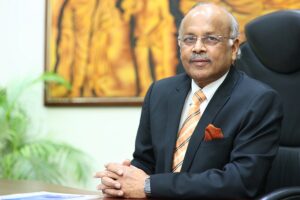
Shishir Jaipuria, Chairman, Seth Anandram Jaipuria Group of Educational Institutions
Education
Empathy as a 21st-Century Competency: Developing Emotional Intelligence among Students

Within the conversation of future-ready education, empathy has moved from being characterized as a “soft” individual characteristic to being identified as an essential social and cognitive ability. Frameworks such as the OECD Learning Compass 2030, UNESCO’s Global Citizenship Education, and the World Economic Forum’s Future of Jobs Report put empathy at the forefront of skills required to succeed in an uncertain, interdependent world.
From Emotion to Competence
Empathy is confused with sympathy, yet they are essentially different. Empathy is an active, cognitive, and affective process, the capacity to grasp another’s emotional situation, comprehend it in context, and react creatively. Neuroscientific research, for example, by Decety and Jackson (2004), illustrates that empathy engages both the limbic system, which controls emotional resonance, and the prefrontal cortex, which controls perspective-taking and rational reaction. Briefly put, empathy does not just mean “feeling with someone”, it means thinking with feeling, where intellect and emotion unite to shape behaviour and decision-making.
Early Childhood (Ages 3–6) – Seeds of Empathy
At the age of three to six years, children in early childhood start showing the beginning signs of empathy by what is termed as “emotional contagion” by psychologists. They tend to cry when others cry or smile when others smile due to the observed emotional state. By the time they are four or five years old, according to research conducted by Zahn-Waxler et al. (1992), children start showing other-oriented concern like sharing, comforting, or embracing a fellow child who looks distressed. Empathy at this age is still primarily affect-based; children sympathize with others but possess little ability to grasp intricate frames of mind. Teachers can cultivate these early roots of empathy through narrative, role-playing, and guided social-emotional education that offer the vocabulary and structure to make sense of emotions.
Middle Childhood (Ages 7–12) – Perspective-Taking Develops
By middle childhood, around ages seven to twelve, empathy is increasingly cognitively complex. They start to understand that people might think and feel differently from themselves, an ability outlined in Selman’s stages of perspective-taking. Peer relationships are increasingly important at this stage, and children increasingly become sensitive to fairness, belonging, and group membership. According to research by Eisenberg et al. (2010), this is a critical window for the instruction of moral reasoning in addition to empathy. Cooperative learning activities, peer mediation programs, and community service offer children meaningful opportunities for empathy extension from intimate friendships to include strangers and even members of out-groups.
Adolescence (Ages 13–18) – Abstract and Global Empathy
An important stage in the development of empathy is adolescence, which lasts from the ages of thirteen to eighteen. Adolescents gain the ability to relate to abstract ideas such as global emergencies, injustice, and inequality. According to Blakemore’s (2018) neuroimaging research, adolescent brain regions involved in identity formation and social cognition are more active. However, hormonal changes and heightened self-awareness are also hallmarks of adolescence, which makes young people more reflective. Schools can assist in this area by offering intentional opportunities for teenagers to develop empathy, such as discussion forums that foster critical thinking, service-learning initiatives that are linked to current events, and cross-cultural interactions that extend their horizons. Adolescents can use these activities to channel their growing empathy into constructive civic engagement.
Young Adulthood (18+) – Empathy as Leadership Skill
Empathy matures during late adolescence and young adulthood as a skill that is intricately linked with emotional control, leadership, and ethical choice. Now, it transcends interpersonal interaction to become the hallmark of effective leadership. More employers are realizing this; a 2022 LinkedIn survey indicated that 78 percent of employers view emotional intelligence as equally or even more important than technical skills. Universities and workplaces increasingly require such competencies, and schools can prepare young adults through leadership programs, mentorship positions, and reflective practices that instil empathy in civic and professional life.
Beyond Awareness to Application
While awareness of empathy is valuable, its real utility comes from practice. Schools need to inculcate empathy not only in coursework but in lived experience. Narrative immersion in literature, film, and even virtual reality allows students to step into other people’s shoes. Structured ethical discussions in dialogic classrooms offer the space for respectful disagreement and deeper understanding. Cross-age mentorship, where older students mentor younger ones, develops a sense of responsibility while strengthening bonds across age. Service-learning, when paired with structured reflection, develops empathy into action. Even cutting-edge tools that offer emotional analytics while working in a team can assist students in self-evaluating and managing their emotions, turning empathy into a mindful and deliberate process instead of an automatic reaction.
The 21st-Century Payoff
The dividend of developing empathy in education is significant. In a world of artificial intelligence, empathy is one differentiator that makes us uniquely human. The World Economic Forum (2025) identifies emotional intelligence, empathy, and collaboration as among the future workforce’s top ten skills. Students who can read emotional team dynamics, negotiate across cultures, and build authentic relationships are not just more hireable but indeed invaluable in a fast-paced professional landscape.
Empathy is not a mushy virtue but a developmental skill that develops systematically throughout childhood and adolescence. Schools that deliberately foster it are not just creating smarter students; they are raising wiser, kinder citizens who can lead with compassion and resilience. Empathy is a moral and practical necessity for 21st-century education, the bridge that unites emotional intelligence and the needs of an interconnected world.
(This article is authored by Dr. Silpi Sahoo, Chairperson, SAI International Education Group)
Education
Math Meets Machine: How AI Is Revolutionising Classroom Learning

In a world where algorithms power everything from our social media feeds to self-driving cars, it’s no surprise that Artificial Intelligence (AI) is transforming one of the oldest pillars of education—math learning in the classroom. Once confined to textbooks and chalkboards, math instruction is now getting a high-tech upgrade, ushering in a new era of personalised, engaging, and data-driven learning.
Cracking the Code: Why Math Needs a Makeover?
Let’s face the fact that many students see math as abstract, intimidating, or just plain boring. Traditional classroom approaches often take a one-size-fits-all route, leaving behind both the struggling learner and the gifted problem-solver. This is where AI steps in, not to replace the teacher, but to empower them with tools that adapt to each student’s pace, gaps, and style.
Enter AI: The Digital Math Mentor
Imagine a classroom where a student struggling with fractions gets instant, visual explanations tailored to their exact misunderstanding. At the same time, another who excels in geometry is offered advanced challenges to stretch their thinking. AI platforms are doing just that. They use real-time data to analyse student responses, detect patterns of error, and provide feedback that feels like one-on-one tutoring.
Far from replacing educators, AI acts as a powerful teaching assistant. Teachers can use AI dashboards to spot who needs extra help, where the class is lagging, or what concepts need reteaching without spending hours on manual assessments. This frees up more time for creativity, collaboration, and real-life math applications that bring numbers to life.
AI also allows classrooms to become more inclusive and equitable. Language barriers? AI can offer multilingual support. Visual learners? Dynamic simulations and interactive tools adapt seamlessly. Students with special needs? Personalized pacing ensures no one falls through the cracks.
What’s Next? The Future of Math + AI
As AI grows more sophisticated, so does its potential in math classrooms. Think AI-generated practice problems based on local news, gamified learning paths that turn algebra into an adventure, or virtual tutors available 24/7 for homework help.
But with great power comes great responsibility. Educators, parents, and developers must ensure that AI tools remain ethical, transparent, and supportive, not controlling or biased.
Math education is no longer just about memorising formulas or solving problems on paper. In the AI-powered classroom, it’s about curiosity, connection, and confidence. With the right blend of technology and teaching, we’re not just raising better mathematicians but combining critical thinking with the subject for a world powered by data and driven by ideas.
This article is authored by-

Ranjith P C, Head Curriculum Excellence, TVS Education
Education
Nirvaan Birla on Why Social Media Needs a Rethink in Today’s Classrooms
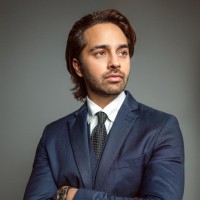
What happens when self-worth becomes a scrolling statistic? When confidence is measured in likes, validation is sought in comments, and a missed post feels like a missed opportunity, social media quietly becomes more than a platform; it becomes a mirror that distorts.
For the younger generation, the digital world isn’t an escape. It’s their reality. What once was a space for fun and connection now silently dictates their self-image, decisions, and even mental health. A carefully crafted caption, the right filter, or a viral reel can spark joy, but it can also fuel anxiety, insecurity, and constant comparison.
As engaging as social media is, it comes with an invisible cost. The pressure to be constantly available, consistently appealing, and endlessly relevant can take a toll. Many teenagers find themselves trapped in a loop of approval-seeking, often mistaking online popularity for personal worth.
Online peer pressure has evolved from being subtle to strategic. Likes are currency, stories are reputation, and every post is performance. Combine that with cyberbullying, misinformation, and the relentless pace of content, and you’ve got a digital space that’s as overwhelming as it is addictive.
Yet, knowing how to use social platforms doesn’t mean knowing how to handle them. Digital literacy has surged, but digital emotional intelligence still needs nurturing.
Recognising the urgency of this shift, Nirvaan Birla, Founder of Birla Open Minds, shared, “We see it every day. The impact social media is having on the younger generation’s mental and emotional wellbeing is significant. That is why at Birla Open Minds, we have initiated sessions like ‘Likes vs. Life’ across our schools. These sessions are designed to help learners reflect on their relationship with social media, how it affects their confidence, their focus, and their sense of self. Our larger vision is to shape not just academically strong individuals but also emotionally resilient ones who can navigate the digital world with awareness and responsibility.”
The idea isn’t to villainize social media. It’s to humanize its users. What the younger generation needs most isn’t just digital access, but digital awareness. The ability to pause. To question. To ask: Is this who I really am, or just who I’m trying to be online. Because beyond the reels, hashtags, and likes lies something far more important: life. And that should never be lived for an algorithm.
Education
Teaching Privilege: Why It Belongs in Every Classroom
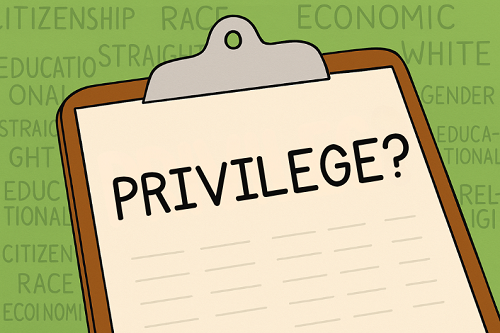
Here’s the thing about privilege: most of us don’t even realise how it shapes our choices, our comfort zones and the opportunities we chase
I’ve been thinking about this for a while now, but it hit me harder during a recent conversation with a college student. One of the factors they had in mind while choosing their higher education institution was that most of the students there came from similar economic backgrounds. They felt uneasy at the thought of being in a space where others might be less privileged than them. And just like that, it became clear: even the discomfort of being around inequality is, in itself, a kind of privilege.
Here’s the thing: privilege wears many faces. Money, yes. But also caste. Gender. Language. Skin tone. Disability. Geography. And then there’s what Gen Z calls “pretty privilege”—the unspoken perks of fitting society’s standards of attractiveness. These aren’t abstract ideas. They play out every day—in who gets picked, who gets heard, who gets help without asking.
This isn’t about guilt. Guilt gets us nowhere. Awareness, though? That’s powerful. Students should be taught to recognise the invisible lifts they get. It’s not just that some kids have better shoes—it’s that they’ve never had to worry about having shoes. It’s not just about who studies in English-medium schools—it’s about who gets praised for speaking English at all.
Privilege doesn’t cancel out hard work. It explains the head start. And when students understand that, they become better humans. They stop seeing success as a solo act and start acknowledging the small privileges they enjoy. These can be supportive families, access to tutors, clean water, a safe route to school. Things so normal for some, they fade into the background. Afterall, acknowledgment is the first step to building empathy.
So where do schools come in? Right at the heart of it. Not with token assemblies or once-a-year poster competitions, but with consistent conversations. Through stories, books, theatre, debates—whatever gets them to look up from their own experience and into someone else’s. Not to feel bad, but to build perspective. And maybe, just maybe, to use their privilege to lift someone else.
This isn’t about shaming anyone or turning life into a comparison game. It’s about empathy and responsibility. When students know they benefit from privilege, they can harness it to help others. They can mentor younger kids, fundraise for resources, or simply speak up when they see inequality in the classroom.
This isn’t a curriculum change. It’s a mindset shift. It’s the difference between raising achievers and raising citizens. If we teach kids to see both their own comfort and the struggles of others, we’ll nurture a generation that doesn’t just accept their advantages but shares them too.
If we want an education system that prepares students for the real world, then recognising privilege isn’t a side-topic. It’s foundational.
(This article is authored by Dhruv Chhabra, Lead-Content and Design at ScooNews and reflects the author’s personal beliefs and lived observations as an education journalist and storyteller. It is written with the hope that classrooms can become kinder, more aware spaces.)
Education
India Plans Unified Higher Education Regulator: What the HECI Bill Means

India is on the verge of a major overhaul in how it governs higher education, with the government aiming to replace the University Grants Commission (UGC), All India Council for Technical Education (AICTE), and National Council for Teacher Education (NCTE) with the proposed Higher Education Commission of India (HECI). The move, aligned with the National Education Policy 2020, seeks to create a more efficient, autonomous, and accountable regulatory system.
Why Replace UGC, AICTE & NCTE?
The current structure—with multiple agencies overseeing different sectors—has long faced criticism for being fragmented and bureaucratic. Overlaps in jurisdiction, slow decision-making, and limited autonomy for institutions have prompted calls for reform. Committees like the Yash Pal and National Knowledge Commission have recommended a unified regulator to reduce red tape and improve coordination.
What HECI Will Look Like
According to the draft and Lok Sabha updates by Education Minister of State Sukanta Majumdar, HECI will have four independent verticals:
-
Regulation (NHERC) – compliance and governance
-
Accreditation (NAC) – quality assurance
-
Grants (HEGC) – performance-based funding
-
Academic Standards (GEC) – curriculum and learning outcomes
This “light but tight” approach aims to foster innovation and autonomy while maintaining integrity and transparency.
Potential Benefits
-
Streamlined oversight: Instead of navigating multiple authorities, institutions will liaise with one regulator.
-
Better resource allocation: Integrated funding vertical offers performance incentives, echoing models in the UK and Australia.
-
Unified standards: Accreditation and curriculum will be uniform, reducing interstate disparities.
-
Global alignment: Can enhance India’s appeal with international quality frameworks.
Risks & Concerns
-
Centralisation: Experts warn that vesting extensive power in one body may over-centralise control, risking academic freedom.
-
Loss of specialised oversight: Domain experts from UGC, AICTE, and NCTE may be diluted.
-
Bureaucratic inertia: Transition could bring its own delays and resistance from existing bodies.
-
Compliance complexity: Institutions may face confusion adapting to new norms and vertical structures.
Global Inspiration & Way Forward
Many countries offer models worth emulating: the UK’s Office for Students (OfS), Australia’s TEQSA, and the US’s accreditation agencies show that one-regulator systems can work—if they strike a balance between oversight and autonomy. The NEP framework supports this, but success hinges on a smooth transition, capacity building, and safeguarding academic freedom.
In short, HECI is more than an institutional reshuffle. It has the potential to redefine Indian higher education—if implemented thoughtfully. The challenge now lies in building consensus, streamlining regulatory roles, and ensuring this new body empowers institutions, not constrains them.
This news has been sourced from various media outlets, with parts of it written and contextualised by the ScooNews editorial team.
-
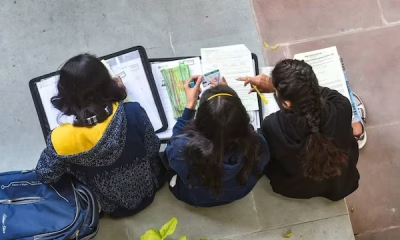
 Education2 months ago
Education2 months agoNCERT Launches New Class 5 & 8 Textbooks, Makes Art Education Mandatory
-
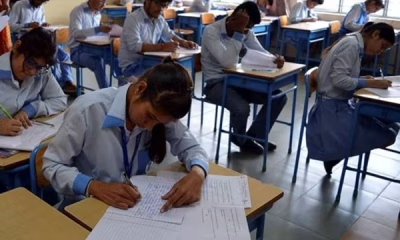
 Education3 months ago
Education3 months agoCBSE To Conduct Board Exams Twice for Class 10 from 2026
-
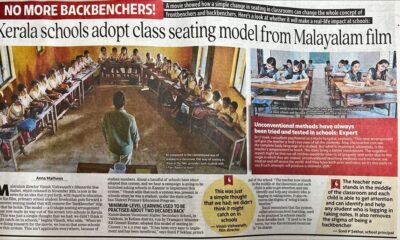
 Education2 months ago
Education2 months agoNo More Backbenchers: How a Simple Seating Shift Is Reimagining Learning
-

 Education3 months ago
Education3 months agoGovernment Doubles Down on Coaching Centres: New Panel Signals Stronger Regulation Ahead
-
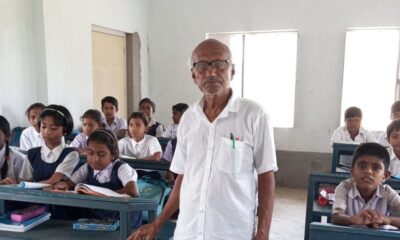
 Education2 months ago
Education2 months agoThe Man Who Called His Students Gods: Dwijendranath Ghosh
-
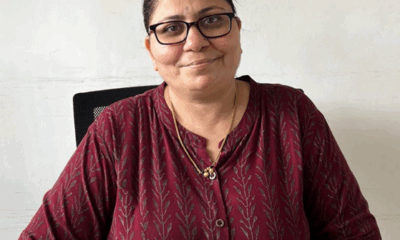
 Education2 months ago
Education2 months agoIn Every Smile, a Victory – Sandhya Ukkalkar’s Journey with Jai Vakeel’s Autism Centre
-

 Education2 months ago
Education2 months agoIndian Army to Sponsor Education of 10-Year-Old Who Aided Troops During Operation Sindoor
-

 Education2 months ago
Education2 months agoNCERT’s New Class 8 History Textbook Addresses “Darker Periods”, Highlights Religious Intolerance and Resilience
-
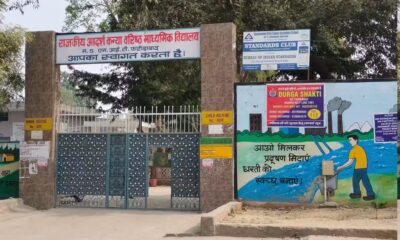
 Education3 months ago
Education3 months agoFour Indian Schools Shine on the Global Stage at World’s Best School Prizes 2024
-
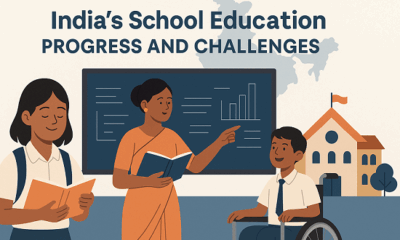
 Education3 weeks ago
Education3 weeks agoBeyond the Numbers: Reading Between the Lines of UDISE+ 2024–25




